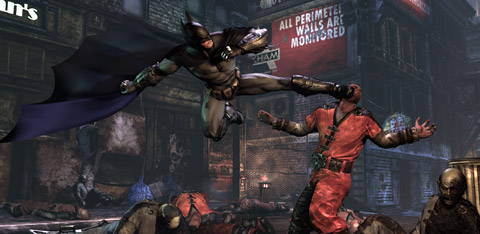What must it feel like to be Batman? The better comic books and movies have given Bat-fans a sense of the hero's tortured inner life. Batman: Arkham City doesn't shy away from the psychological questions haunting the Caped Crusader, either. A darker tale than that of its predecessor, 2009's Arkham Asylum, the new game challenges Batman with a city full of freaks to deal with, and a toxin in his bloodstream that will kill him if he doesn't find the antidote. But the sequel also accomplishes something else: it gives us a tactile sense of what it feels like to don the Batsuit."Arkham City" is the name for a walled-off section of Gotham that has been transformed into a prison for the city's most dangerous criminals. It's a convenient premise for an overstuffed plot that features cameos from nearly every member of Batman's rogues' gallery, but it's also a wide-open playground to experiment with the gadgets at the Dark Knight's disposal. Arkham City's signature achievement is a movement system that allows Batman to alternate between his grappling hook and glider to circumnavigate the city in an unbroken sequence. If there were no gameplay objectives at all, soaring across the city would still be a blast.
Unlike some games that claim to offer a wide-open experience but restrict your movement to small areas for hours at a time, the squalid environs of Arkham City are fully accessible from the start. Even a large portion of the map marked "restricted" can be infiltrated if you try hard enough. This is not a game that relies on arbitrary barriers for its challenge. Instead, it offers cerebral platforming segments that demand close attention to your surroundings, well-designed side missions that are enjoyable for more than just bonus experience points, and frequent brawls that remain gaming's gold standard for third-person hand-to-hand combat.

GOOD GADGET If there were no gameplay objectives at all, soaring across the city would still be a blast. |
Combat in Arkham City, like losing weight or saving money, is simple but not easy. Rather than mastering complex button machinations, winning a fight requires you to keep a steady rhythm to your attacks and counterattacks, even as thugs swarm Batman from all sides. What unfolds onscreen is a kind of dance, which looks graceful and almost beautiful up until the point that you hear a bad guy's arm snap.The city is so big and dense with side missions that it can't help but fall prey to the central problem of most open-world games. The narrative wants you to feel the urgency of Batman's predicament and find a cure as soon as possible, but the gameplay wants you to stop, explore, and collect 440 hidden Riddler trophies along the way. Similar optional elements were present in Arkham Asylum, but that smaller game never lost its focus. To the extent that Arkham City wants to give players a sense of participating in a living world, it also sacrifices some of the tension that distinguished its predecessor.
On the other hand, maybe Arkham City gives players the truest sense of what life must be like for a superhero. Supervillains everywhere, a bloodborne disease about to kill you, and now some poor schmoe is getting mugged and begging for your aid. You're Batman — how can you ignore even a single cry for help and be able to live with yourself? It's enough to drive a person crazy.